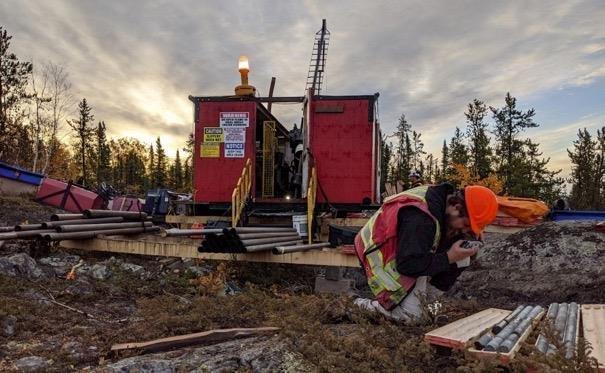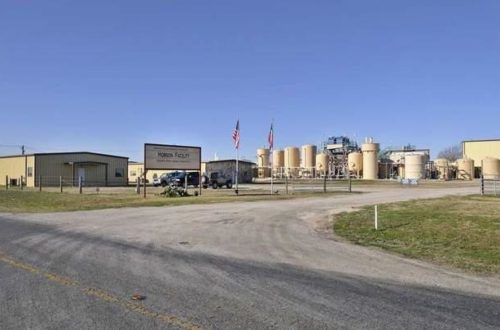
Gold Terra Resource Growing Resource To 1.2Moz Gold, Looking For Much Bigger Prize
By achieving the 1.2Moz number, CEO David Suda already passed the important threshold of a potentially 1Moz mineable resource I f all exploration to grow the deposit further from here would fail, they could always advance the current resource into a very decently sized development project, as I estimated an after tax NPV8 of almost US$300M at a gold price of US$1500/oz for such a project Not bad for a junior with a current market cap of C$57M. But I don’t expect it to end here, and management certainly doesn’t either.
All presented tables are my own material, unless stated otherwise.
All pictures are company material, unless stated otherwise.
All currencies are in US Dollars, unless stated otherwise.
It is good to see that CEO Suda and Executive Chairman Panneton don’t waste any time, and don’t communicate unrealistic expectations. The updated mineral resource estimate on its Yellow knife City Gold project is on schedule, and above the global estimate of “hopefully more than 1Moz”. Panneton didn’t even assign much value to the current resource during a recent webinar discussing the new resource estimate, as he has seemingly placed all his bets on the Campbell Shear target. I wouldn’t go that far yet, as my calculations indicate a solid operation based on Sam Otto, Crestaurum, Mispickel and Barney, but it is good to see he has so much confidence in the Campbell Shear story. In my view i t is a good thing to have a binary exploration play like this backstopped by a solid resource. Markets like this, and so do I, as investors in mining juniors often have to deal with disappointments. Not so with this management team so far, which is a big p lus in my book.
The updated mineral resource estimate includes the Sam Otto, Crestaurum, Barney and Mispickel gold deposits previously reported in the initial November 2019 NI43 101 compliant resource estimate, and includes assay results from the 2020 dri ll program on the Sam Otto (9,622 metres) and Crestaurum (7,648 metres) deposits. Please note that no drill results on the Campbell Shear target were included (or disclosed publicly) so far, while this target is the main focus of management since optioning it from Newmont last year.
Management expects to release the first Campbell Shear drill results from holes GTCM21 001 and GTCM21 002 (see news release of February 4, 2021) in the next week. The drilling of two other holes started in February, one at depth and another as a 500m step out from hole GTCM21 002. Results of these holes are expected in the coming weeks with follow up drilling plans for another 10,000 meters funded with the recently closed private placement.
Let’s have a look at the updated resource. I compared the March 2021 resource with the November 2019 resource, to see what changed exactly:
The most important aspect is of course the increase in ounces, as i t is a meaningful increase ( but much more important the figure is well above an industrywide threshold of 1Moz Au, as this enables two other important thresholds for mine financiers with some margin: an annual gold production of 100.000oz Au, and an 8 year life of mine. So Gold Terra is safe for the number of ounces. Of course things like conversion to Measured Indicated, metallurgy, continuity, strip ratio, rock competence, dilution etc etc all will have their say in future resource estimates and economic studies, but we are out for a promising start in my view, and this view is shared by management which has much bigger plans.
When looking at the table, the largest increase can be found at the Sam Otto deposit, which singlehandedly lifted the to tal ounces over the magical 1Moz barrier. The smaller deposits also saw increases across the board, although they had less impact due to their much smaller size. In my last article about Gold Terra I suggested to use a lower cut off grade, as the gold pri ce is much higher now, and management did just that (based on a gold price of US$1500/oz now vs US$1300/oz in the 2019 resource estimate) but remained conservative on the much larger open pit part of the resource, as the cut off was lowered from 0.5g/t Au to just 0.4g/t Au.
This means the company found most new ounces by drilling, not by lowering the cut off grade, which is positive of course. At the smaller underground part they had to lower the cut off a bit more at Barney and especially Sam Otto, where the average grade dropped from 3.65g/t Au to just 1.75g/t Au. This in turn, together with the other somewhat lower grades of the other deposits, caused the underground average grade to drop from 5.7g/t Au to 4.04g/t Au, which is significant. Notwithstandi ng this, the grades are still pretty economic according to my estimates.
It was good to see that high grade capping has been done, but not too low, as the nearby Con Mine, which serves as a proxy for Campbell Shear exploration targets, had lots of its ounces defined by high grade pods with average grades over 50 60g/t according to my calculations.
Interesting was the part of the news release describing potential mining methods for the various underground deposits, already indicating costs which can be used for your own back of the envelope estimates:
“The pit shells were created using Whittle pit optimization software and applying the following optimization paramet ers: US$1,500 gold price; US$2.20/tonne for mining cost; US$16.00/tonne for processing and G&A costs; 90% metallurgical recovery; 5% dilution ( 5% mining loss; and 60° pit slopes (the deposits occur in areas of extensive outcrop with negligible o verburden).
A review by SGS engineers of the size, geometry and continuity of mineralization was conducted to determine underground mineablility of the deposits. On the Sam Otto dep osit it was concluded that bulk underground mining below the pit shells was possible, and a cut off grade of 1.4 g/t Au is used to define underground inferred mineral resources on this deposit using an underground mining cost of US$44.00/tonne and US$16.00 /tonne processing and G&A costs. Similarly, bulk underground mining at the Barney deposit uses a cut off grade of 2.0 g/t Au and a mining cost of US$68/tonne with US$16.00/tonne processing and G&A costs. Crestaurum is considered a high grade selective mini ng deposit and a 2.5 g/t cut off grade is used with a mining cost of US$79.00/tonne with US$16.00/tonne processing and G&A costs.”
UndergroundUnderground miningmining costscosts ofof overover US$68/tUS$68/t toto eevenven US$79/tUS$79/t seemseem pretty high for the average grades in question but are undoubtedly caused by the small scale of the underground deposits. I do wonder if these expensive underg round deposits help the profitability of the entire project though. Management had this to say Not only are t he re are opportunities to make th ese deposits larger and therefore more economic the se deposits may also be sweet e ners to a potentially larger cornerstone deposi t in the South Belt of the Campbell Shear.
Management also sees opportunities to increase the number of ounces in the Crestaurum and Sam Otto deposits as stated in the news release:
- “The untested dept h extension on both the Sam Otto Main and the Sam Otto South deposits. Both Sam Otto deposits are open to the North and at depth and it is recommended to follow up with a drill program at depth below the current deposit outline or below the 250 metre verti cal depth.
- Selective closer spaced drilling at the Crestaurum deposit can potentially increase mineral resources below the 300 metre depth. SGS Geological Services constrained the Crestaurum deposit to above 300 vertical metres as 2020 drilling below this depth and down to 500 vertical metres that successfully intersected the gold structure was deemed too widely spaced to be included i n the inferred mineral resource.
- In addition, 2020 drilling on the Crestaurum deposit revealed an untested three kilometre strike length of this gold bearing structure to the south of the current resource, possibly extending to the Ranney Hill high grade s howings on surface and effectively tripling the strike length of this gold bearing structure.
- A review of the structural controls on the Mispickel and Barney deposits during th e 2021 mineral resource estimation revealed potential for increasing these higher grade zones both along the plunge of the known high grade zones, and for discovery of new high grade lodes over a potential three kilometre mineralized structure at Mispickel
When interpreting these recommendations, another 300 500koz Au should be a realistic target in my view. Management has already outlined where the potential is in their resou rce update news release The beauty of the Gold Terra story is that expanding the existing resource around Sam Otto, Crestaurum, Mispickel and Barney is the backstop of a potentially much larger narrative, fueled by the Campbell Shear target. If the compan y hits something substantial over there all bets are off and Panneton might see his 3 5Moz target come into reality.
In order to be able to continue drilling at not only the existing resource, but also the Campbell Shear target at full force t he compan y successfully raised C$2.88M on March 4, 2021, exactly as planned through a non brokered private placement at C$0.36, with no warrant and at a premium and with the usual 4 month and one day hold period. According to management, the placement was done by one Canadian institutional, who came in as an acquaintance of Panneton, and also invested in the Detour project when Panneton was at the helm. As it is flow through, all proceeds will be used for explorati on purposes, and more specific will be used to expand the current 10,000m drill program at the Campbell Shear Zone target to over 20,000m. The current cash position stands at C$ 6.3 M.
The chart of Gold Terra Resource looks like this:
The dissemination of the news release about the updated resource was timed well, as positive sentiment seems to return to the markets, after Biden had his 1.9T package signed by the US House. This weakened the US Dollar a bit, and this in turn supported ( prices. I do believe the bottom is in for Gold Terra after they announced their 1.2Moz resource, and as long as gold stays above US$1700/oz.
As mentioned, 1.2Moz is a very nice resource to have, but t he main goal for management is to find another Campbell S hear, which hosted approximately 5 of the 6 million ounces of gold produced at the former Con Mine The Phase 1 Campbell Shear drilling covers only a small portion of the nearly 70 km of strike length on the southern and northern extensions of the shear system that hosts both the former Con and Giant gold mines which historically produc ed over 14 million ounces of gold. On a sidenote, a s some in the audience might know, the former Giant Mine ha s seen, besides lots of gold production also its fair share of trouble, as there was an explosion by a bomb which killed 9 workers during a strik e in 1992 and massive pollution over the years, for which a recent remediation plan estimated the costs between C$900M and C$1B. The Giant M ine ore consisted predominantly of refractory ore, of which treating in the old days generated a large amount of th e very toxic arsenic trioxide, which has been stored underground until this day but needs to be frozen permanently according to the plan in order to prevent leaking Fortunately, the Con Mine, and the current resource areas of the YCG project don’t have r efractory ore, and the Con Mine has been demolished and cleaned up in part, being asbestos free at the moment, awaiting full remediation by its current owner Newmont.
As a reminder, i n November 2020 Gold Terra announced the start of a drilling program to test the Campbell Shear which is well underway now. In the Phase 1 program, the company planned to drill 12,000 meters (up to 19 holes) testing over 1.2 kilometres of strike extension of the Campbell Shear at 125 150m spacing, at vertical depths between 250 and 600 metres to extend known gold mineralization. Depending on the results of this first pr ogram, a deeper Phase 2 program will be planned, which will include a series of holes testing the Campbell Shear at 800 metres depth.
Since the number of ounces changed for Gold Terra it seemed useful to me to update the peer comparison as well, to see where the company ranks now on valuation metrics:
As the EV/oz metric was pretty high for Gold Terra ( considering the not very adva nced stage the updated resource certainly brings it down to somewhat more healthier levels, despite the recent increase in share price. Gold Terra surely can’t be seen as an undervalued stock for what they have at the moment, but since the potential is mu ltiples of the current resource, the investment thesis remains pretty interesting. This is also based on my back of the envelope estimates of a US$300M NPV8 US$1500/oz Au based on 1Moz Au, in the worst case exploration doesn’t bring the results managemen t is hoping for. Fortunately, there are no indications yet that suggest such a scenario, and it is up to the drill bit to show proof of the true potential of the Campbell Shear.
Conclusion
With the release of an updated NI43 101 compliant resource estim ate of an Inferred 1.2Moz Au at their Yellowknife City Gold project, Gold Terra has put itself firmly on the radar of the mining community The limited use of lower cut offs, only a realistic thing to do at higher gold prices, shows an increase mostly base d on drilled ounces, which makes this resource update a qualitatively good one. I expect the current resource being able to grow with another 300 500koz Au, but the potential big prize will be in the drilling of the Campbell Shear, which is ongoing at the moment, and the first drill results of this program are expected next week.
If Gold Terra achieves strong results there, it might be the last time the share price has seen current levels.
I hope you will find this article interesting and useful, and will have further interest in my upcoming articles on mining. To never miss a thing, please subscribe to my free newsletter on my website www.criticalinvestor.eu, in order to get an email notice of my new articles soon after they are published.
Disclaimer:
The author is not a registered investment advisor, and currently has a long position in this stock. Gold Terra Resource is a sponsoring company. All facts are to be checked by the reader. For more information go to www.goldterracorp.com and read the company’s profile and official documents on www.sedar.com, also for important risk disclosures. This article is provided for information purposes only, and is not intended to be investment advice of any kind, and all readers are encouraged to do their own due diligence, and talk to their own licensed investment advisors prior to making any investment decisions.
Swiss Resource Capital AG
Poststrasse 1
CH9100 Herisau
Telefon: +41 (71) 354-8501
Telefax: +41 (71) 560-4271
http://www.resource-capital.ch
CEO
Telefon: +41 (71) 3548501
E-Mail: js@resource-capital.ch
![]()



